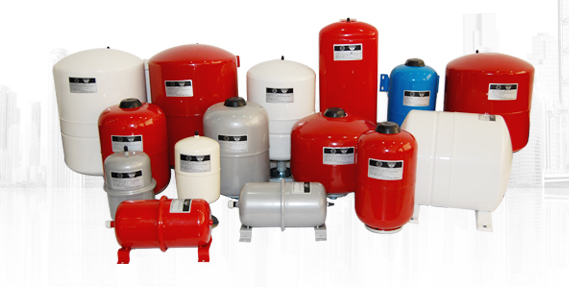
Installation and hydration design of atmospheric expansion water tank
The expansion tank is an important part of the hot water heating system and the central air conditioning waterway system. Its function is to contain and compensate for the expansion and contraction of water in the system.
Generally, the expansion water tank is set at the highest point of the system, and is usually connected to the return water main pipe near the suction port of the circulating water pump (central air conditioning chilled water circulating water pump).
The expansion tank is a steel welded container with various sizes and specifications. The following pipes are usually attached to the expansion tank:
(1) An expansion tube that transfers the volume of water in the system due to the expansion of heat into the expansion tank (connected to the return main road).
(2) An overflow pipe for discharging excess water in the water tank exceeding a prescribed water level.
(3) Signal tube for supervising the water level in the water tank.
(4) The circulation pipe is used to circulate water (in the center of the bottom of the tank and connected to the main road) when the water tank and the expansion pipe may freeze.
(5) Sewage pipe for sewage disposal.
(6) The water supply valve is connected with the floating ball in the tank. When the water level is lower than the set value, the valve is replenished with water.
For safety reasons, no valves are allowed on the expansion and overflow pipes.
The expansion tank is used in the closed water circulation system to balance the water volume and pressure, avoiding frequent opening of the safety valve and frequent replenishment of the automatic water supply valve. The expansion tank functions to accommodate the expansion water, and can also function as a water supply tank. The expansion tank is filled with nitrogen gas, and a large volume can be obtained to accommodate the amount of expansion water. The high and low pressure expansion tanks can be connected to the voltage stabilization system by using their own pressure. Replenish water. The control of each point of the device is interlocking reaction, automatic operation, small pressure fluctuation range, safe and reliable, energy saving, and good economic effect.
The main role of setting the expansion tank in the system:
(1) swell, so that there is room for expansion after the fresh water in the system is heated;
(2) Replenishing water, replenishing the amount of water lost in the system due to evaporation and leakage and ensuring that the fresh water pump has sufficient suction head.
(3) Exhaust, the air in the exhaust system;
(4) administering a chemical, and administering a chemical to chemically treat the cooling water;
(5) Heating, if a heating device is provided therein, the cooling water can be heated to warm the cylinder.
The installation position of the expansion tank should be considered to prevent the freezing of water in the tank. If the tank is installed in a non-heated room, insulation should be considered.
The expansion pipe is connected to the top of the water supply main riser in the gravity circulation system; when it is connected to the system constant pressure point in the mechanical circulation system, it is generally connected to the water inlet of the pump, and the circulation pipe is connected to the horizontal return water main pipe before the constant pressure point of the system. Above, between this point and the constant pressure point, it should be kept at a distance of not less than 1.5-3m. This allows a small amount of hot water to slowly flow out of the water tank through the circulation pipe and the expansion pipe to freeze the water in the waterproof case. In the gravity cycle, the circulation pipe is also connected to the water supply main pipe, and should also be kept at a certain distance from the expansion pipe.
It is strictly forbidden to install valves on expansion pipes, overflow pipes and circulation pipes, and valves should be installed on drain pipes and signal pipes.
The expansion pipe installed in the non-heating room shall be insulated by the circulation management system and signal tube.
The water temperature in the general open expansion tank should not exceed 95 °C.
The atmosphere communication pipe should not be inserted into the water tank or the water level of the tank, and it is strictly forbidden to install the valve.
The hydration design of the expansion tank:
There are two ways to replenish the expansion tank:
1) Float valve automatic water supply - When the water quality of the living water supply in the area is soft and the refrigeration device has no special requirements for the quality of the refrigerant water, the roof life water supply tank can be used to directly replenish the expansion water tank through the float valve. At this time, the expansion tank is at a certain height lower than the life water tank.
2) High and low water level controller hydration - When the water quality of the living water supply in the area is hard and the refrigeration device (for example, lithium bromide absorption type cold water chiller) requires the refrigerant water to be softened water, high and low water level sensors should be set in the expansion water tank to control Start or shut down the softened water make-up pump. Once the water level is lower than the signal tube, the make-up pump will automatically replenish the system. This method requires a set of softened water treatment equipment. The water supply pipe from the make-up water pump can be connected to the water collector or to the suction port of the refrigerant water circulation pump.
- Prev :Central air conditio
- Next :Expansion tank intro
- Share:
- Back to News List
Product List
Contact
-
Zhejiang Lejiajia Thermal Energy Technology Co., Ltd.
-
Add:No. 3, Kangzhuang Road, Daxu Industrial Zone, Xicheng, Yongkang, Zhejiang, China
-
Tel:0086-579-87486166
-
Fax: 0086-579-87486169
-
E-mail:sales@zjljj.com

